Bullock Brothers, Photographers
Davenport Station home | Index to History pages
I hope this article is of interest - if anyone can fill in more of the story I'd be very pleased to hear from them. - Charlie Hulme
The Bullock photography dynasty can be traced back to two brothers, Edward and Thomas Bullock.
Edward Bullock was born in 1808 in Bolton, Lancashire . The 1851 census records him as a widower and 'artist, portrait painter' living in Charles Street, Cheadle, Staffordshire, with his children Mary (16), William (15), Elizabeth (14), James (12), and Edward (10) plus Edward's sister Martha (28) acting as housekeeper.
By 1861 he had re-located to the popular Victorian resort of Leamington Spa, Warwickshire, with William, James and Martha, and also as his niece Elizabeth. Like many portrait painters of the time, he would have realised that photography offered a quick way to produce portraits, and James and Edward joined him in a photographic enterprise based at 20, Lower Parade in Leamington, a fashionable address not far from the Pump Room where visitors would 'take the waters.'

The Leamington Bullocks were innovators: in 1865 they patented a process for reproducing copies of photographs by lithography.
Thomas Bullock, born in 1811 Cauldon, Staffordshire, between Macclesfield and Leek, was in business in 1851 as a 'Photographic Artist' in Brunswick Street, Macclesfield, Cheshire where he lived with his wife Mary and children Hannah (10), Joseph (9), William (7), Thomas H.(5), Elizabeth (3) and Daniel (10 months).
By 1861 two further sons, Ezra and David had been born, and the three eldest, Hannah, Joseph, and William were working as assistants in the business, by then operating at 2 Hibel Road, Macclesfield where it was to stay for many years, with Daniel, Ezra and David later joining the team as the elder children left home. By the turn of the century, Ezra presided over the Macclesfield studio, with paid assistants.
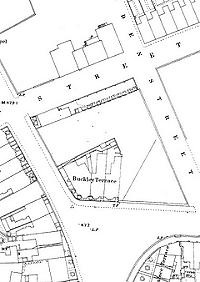
The trading name of the Macclesfield business, at first Bullock and Sons, later (possibly after the death of Thomas, c. 1870) changed to Bullock Brothers. 'Carte de Visite' photographs bear the address as 'Buckley Terrace' - the name of the row of houses in Hibel Road which includes No.2, as seen on the 1874 plan above.
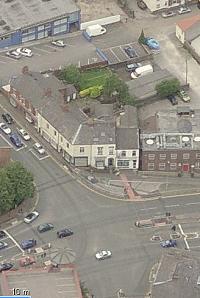
There have been changes to the immediate
area, but the house at 2 Hibel Road survives in 2014: it
is the white one with three skylights in the centre of
the Bing aerial view above.
Ezra Bullock, born in 1853, married Marianne Eliza Guttridge in 1893; it seems they did not have any children.
They continued to live at 2 Hibel Road and Ezra was still was trading as Bullock Brothers in 1914. Marianne died in 1929; Ezra died in 1941, aged 88. An executor of his will was Sydney John Bullock, son of Daniel; he lived until 1970.
The latest date we have seen for photographs taken by, the Macclesfield branch of Bullock Brothers is 1920. Any information on later work would be welcome.
Some of their glass negatives have survived to the present day, and thanks to Macclesfield-based photographer Brian Ollier some of them have appeared as part of local history features in the Macclesfield Express newspaper.
Note: Some or all of the known postcards of Stockport may have been produced in Macclesfield; we have no way of telling at present. However, all the used ones we have seen have postmarks earlier than 1907.
Stockport portraits
Here are two examples of the many portrait 'cartes de visite' produced by the Bullocks. We are grateful to John Chard for providing these from his family collection. Actual size is about 5 inches high.
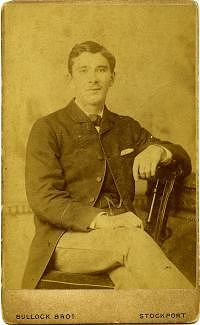
This one (above and below) is from the 108 Wellington Road South studio. The subject is James Arthur Penny, born 1864, probably photographed to commemorate his 21st birthday in 1885. He was the son of Belfast-born John Penny (1816-1891), a Stockport paper merchant, and his second wife Ellen.
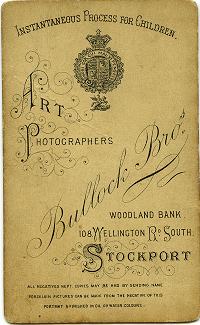
The ornate design of back used in the Wellington Road days.
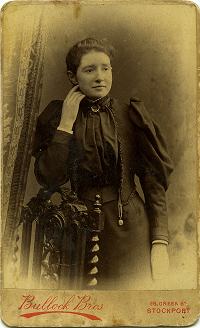
This one is from Greek Street, and is believed to one of James Arthur Penny's sisters, either Clara (b.1863), or Hannah (b.1865.) Hannah tragically died in 1891, the same year as her father.
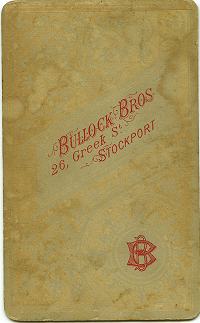
A much simpler design on the reverse of this later card.
Picturesque Cheshire
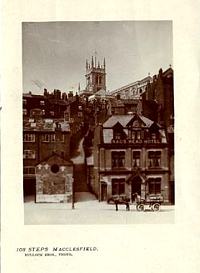
A small selection of postcards (probably) produced by the Macclesfield Bullocks. Above, the '180 steps' in Macclesfield, leading to the Parish Church.
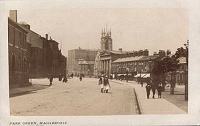
Park Green, Macclesfield, with the church and the classical portico of the Town Hall.
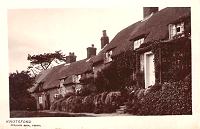
Knutsford.
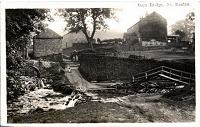
The packhorse bridge over the River Goyt near the Buxton - Macclesfield road. This area has been submerged under a reservoir since the picture was made, and the bridge reconstructed further upstream.
Macclesfield portraits
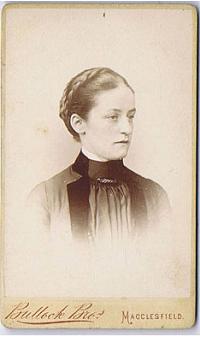
Front and back of a typical Bullock Brothers 'Carte de Visite.'
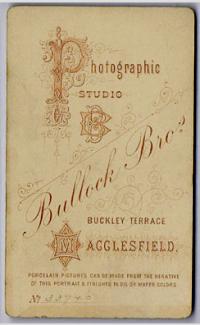
Later ones have a much simpler back design, but the dates of changes are hard to establish without knowing the dates of the pictures. Note the photographer's reference number.
Special thanks to David Bullock, John Chard, John Ollier and the staff of Stockport Local Studies Library for assistance with this article.
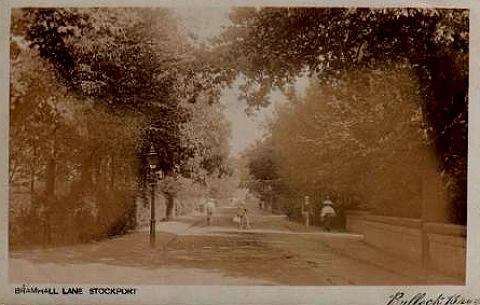
The postcard above, showing the view towards Davenport station from somewhere near the 'Jolly Sailor' inn, dates from c. 1902-3 and bears the imprint of 'Bullock Bros', as do many other cards that can be found traded on eBay and elsewhere. However, the Bullock family were making and selling photographs well before the era of picture postcards began.
Daniel Bullock, son of Thomas, and founder of Bullock Brothers in Stockport, spent some time in Leamington Spa helping his cousin James with the family business there (Edward Bullock died in 1876) and is recorded living with him in the 1881 census. Soon afterwards, however, he moved to Stockport: the first Bullock Brothers studio there was a house (which no longer exists) in 'Woodland Bank', 108 Wellington Road South - portrait cards exist with that address and dated 1882.
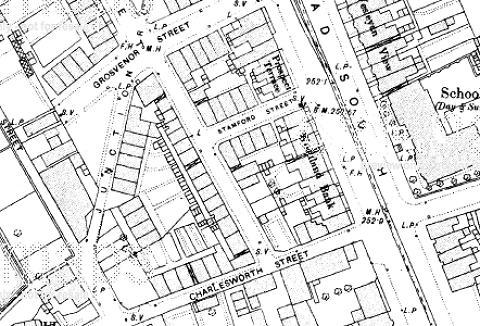
The Wellington Road studio at 'Woodland Bank' (the map above, from around 1900, reveals that the name actually belonged to the whole row, although the name plaque was on 108) was a little outside the town.
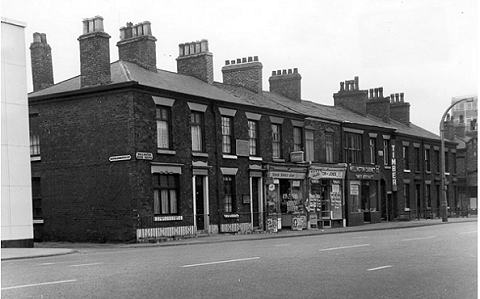
The archive picture above shows Woodland Bank as it was in the 1960s, some of the houses having been converted to shops. No. 108 is the timber merchant's premises to the right of the two shops. By 1974, it had become 'JB Plastics'. Later, the whole row was demolished and Stockport College, one of whose buildings can be glimpsed on the right of the picture, bought the land, although not much was done with the street frontage area until 2008 - 2010 ...
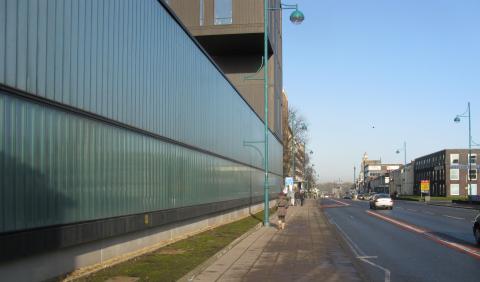
... when the new building shown here, designed by local architects Austin Smith:Lord, which includes engineering workshops and teaching space, was erected on the site. In 2011 it was named 'Building of the Year' at the annual Manchester Society of Architects awards. (Yes, really.)
The accommodation at Woodland Bank was perhaps declared inadequate, especially after Daniel married local girl Susan Matilda Braddock in December 1883, and in February 1885 Daniel purchased a leasehold property, 26 Greek Street, Stockport, one of a row of houses built in the late 1830s as part of what was the beginning of 'fashionable' suburban expansion of the town. By the summer of 1885 the new studio was ready, as announced in the Stockport Advertiser of 3 July:
|
Removal! Removal! Removal! NEW LIGHTED STUDIO IS NOW COMPLETED and well adapted for ALL STYLES OF PHOTOGRAPHY It will be found replete with every comfort to suit their patrons 26 GREEK-STREET (late of Wellington Road South) STOCKPORT |
Daniel and Susan had at least three children, Ernest, Ada and Sydney, and by 1891 they were prosperous enough to employ a domestic servant, Mary Hoe. Susan, Ernest and Ada helped with the photographic work, and after Daniel died tragically young in 1900, they carried on the business.
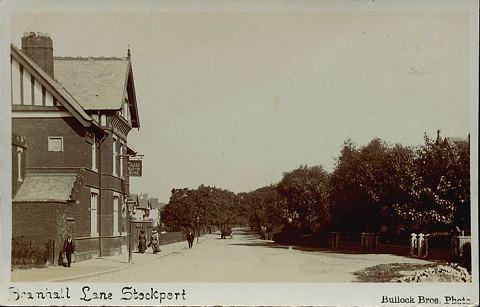
From the 1890s, and especially after 1902 when postcards were permitted by the Post Office to have a 'split back' with the address and message both on the back of the picture, the Bullocks at all three sites added postcard publication to their portrait and general photography. The example above shows the 'Jolly Sailor' hotel in Davenport as rebuilt in 1895.
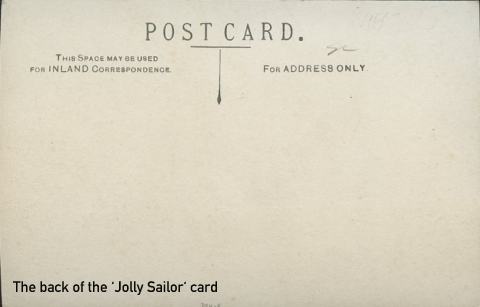
Photographs included Stockport and Macclesfield town scenes, and tourist sights in the Peak District and east Cheshire can also be found.
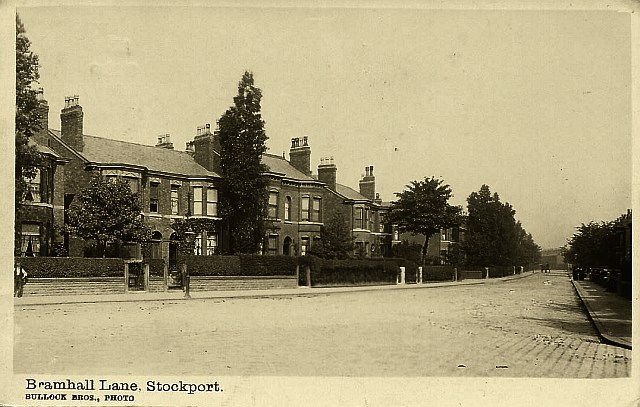
Most have a rather rough-and-ready look to them, and some, especially Stockport examples, seem to have faded badly over the years.
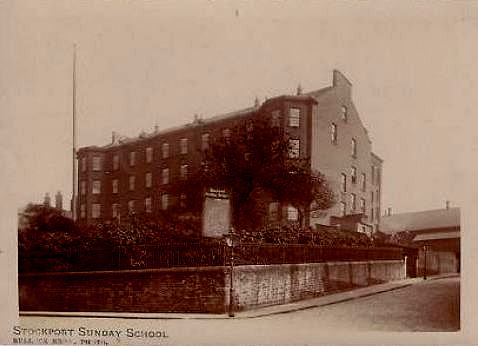
Some of those shown here have been digitally enhanced to make them more visible. No doubt they were cheap, but they cannot compete for attractiveness with the colour cards printed in Germany sold by competitors. They were produced from glass plate negatives, which were sometimes re-touched and otherwise edited by painting on the glass. The 'Buxton Road' view below (which shows mostly Wellington Road South; today Buxton Road begins at the junction with Bramhall Lane in the middle distance) shows signs of this, with the two figures pushing the barrow standing out rather oddly from the scene.
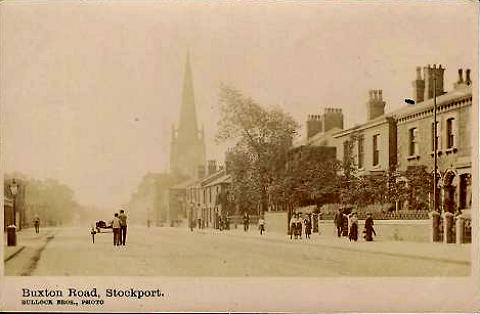
Daniel's widow Susan died, aged just 42, at the beginning of 1907, and the business,along with the house, was sold to the firm of Scott and Frisby. William George Frisby, photographer, moved into 26 Greek Street with his wife Catherine, and daughters Violet, Ruby and Ivy. Violet joined the business: in the 1911 census her occupation is 'photographer's retoucher.' Frisby and his wife were born in London, and at some time lived in Yorkshire, but they had been in Stockport before, as their youngest daughter was born here.
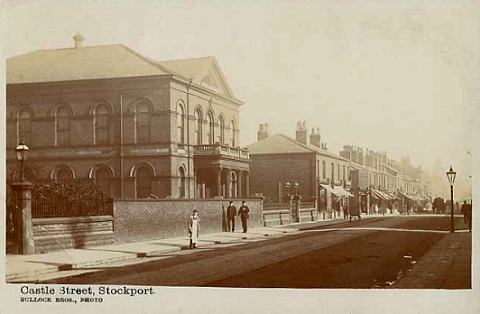
Ernest and Sydney went to live with Susan's father, John Braddock, in Crosby Street, Stockport - Ernest Braddock is listed as 'photographer's assistant' in 1911, which suggests that Scott and Frisby employed him. The business continued under Frisby's auspices for many years, although electoral registers show that in the 1920s he had rented out the living accommodation at 26 Greek Street and moved to a house at 23 Fair View Avenue, Levenshulme, Manchester.
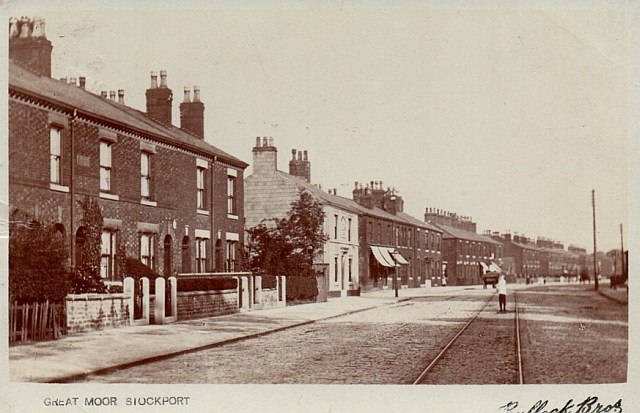
This image of Great Moor shows the track of the horse-worked tram line, which was converted to double-track electric operation in 1905.
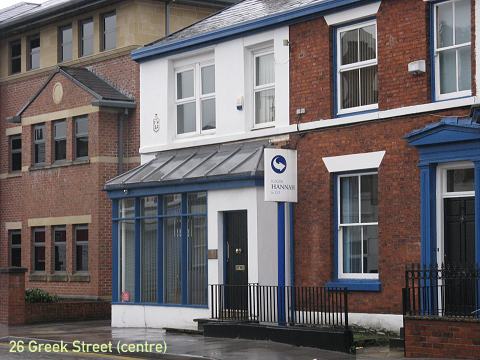
The building at 26 Greek Street still exists, in good condition, in 2021, as rented office accommodation. (The Stockport Corporation fire hydrant sign on the wall is a rare survivor.) I've yet to discover when the photography business ceased - possibly when Mr Frisby retired. There is no evidence that Scott and Frisby produced any postcards; the most prolific local postcard publisher in the years following was 'Grenville Series' of Tatton Street, St. Petersgate, Stockport who produced very many views of Stockport and other local areas, many copies of which can still be found today, but that's another story.
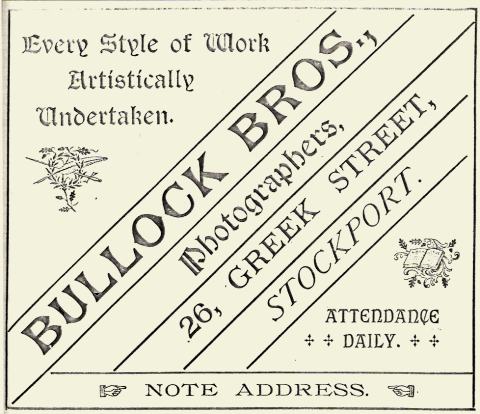
This advert appeared in a Stockport street directory of 1887.
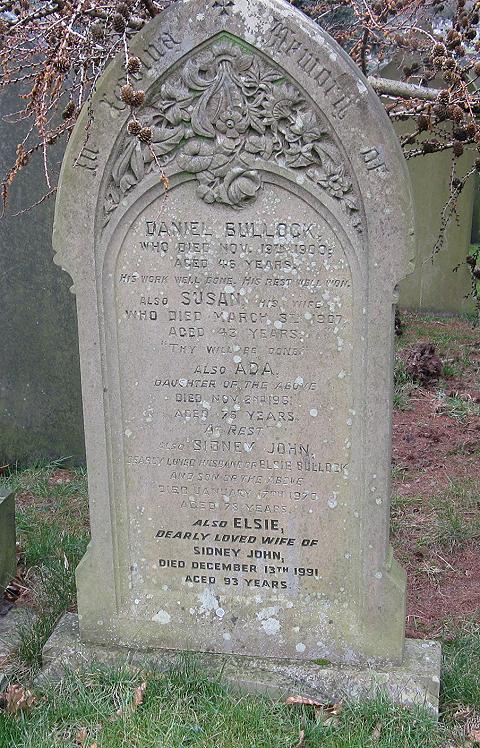
The family grave of Daniel Bullock, Stockport Cemetery. 'His work well done, his rest well won.'
Written by Charlie Hulme, last updated April 2021.
Comments welcome at info@davenportstation.org.uk